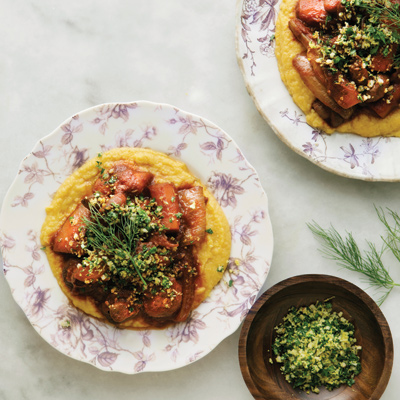Vegan Osso Buco
Like participle and Benedict Cumberbatch, braise is a term that people often toss around but don’t really understand. Braise is a two-step cooking method, in which you first sear the food in a hot skillet, then cover and bake it with a little liquid. If that sounds like one step too many, remember that ordering pizza is even more work because you have to find the phone first.
Osso buco is a quintessential braised Italian dish. It’s flavorful, filling and completely verboten to vegetarians because it’s made with veal shanks. I wondered if I could make a vegan version that was just as warm and wonderful without the baby cow. I sought advice from Cielo executive chef Gianni Colucci, who appreciates osso buco so much that his eyes twinkle, and he says things like, “When making osso buco, you have to respect the tradition. It’s like a poem.” That might be the most romantic thing I’ve ever heard about cooking. Or cattle. Colucci encouraged me to give the osso buco treatment to seasonal root vegetables, including fennel, a vegetable I never remember because it’s not peas or carrots. He also told me to use wine, an ingredient I never forget.
I sauteed the root vegetables, deglazed the pan with equal parts vegetable broth and red wine, and baked the whole shebang until the vegetables were soft. The result was a boozy vegetable soup that lacked the gravitas of osso buco. I thickened it with flour, but the starch didn’t help the thin flavor.
Brandon Benack, executive chef at Truffles and its meat market, Butchery, solved my problem when he revealed the method for his braised lamb saddle chops. In the first step of his braise, Benack coats his sauteed vegetables with tomato paste and allows the paste to caramelize. The darkened tomato paste adds a savory flavor to the sauce and thickens it. Sure enough, a can of tomato paste worked its magic on my root vegetables, giving weight to both the texture and taste.
I was getting close. Before I finalized my recipe, I asked the venerable Vince Bommarito, executive chef at Tony’s, to divulge how he makes his osso buco, a St. Louis favorite for about 27 years. Bommarito told me his (no longer) secret ingredient: a tiny bit of puréed anchovy in the sauce. Far from making the osso buco fishy, the anchovy lends a layer of umami, exactly what my recipe needed. Since I was going vegan, I used a dollop of miso, which is savory, salty and, more important, already in my refrigerator. Use porcini powder, soy sauce or even balsamic vinegar if that’s what you have handy.
Osso buco is traditionally served with creamy risotto. To up my veggie content, I made an equally creamy vegan cauliflower purée and brightened it with saffron, an idea I shamelessly stole from Colucci. I finished the plate with a verdant gremolada, which sounds as pungent as a Benedict Cumberbatch character, but is actually the traditional osso buco garnish of chopped parsley, garlic and lemon zest. Don’t confuse zest with the whole lemon peel, or you’ll get a bitter, inedible garnish. Like osso buco itself, your gremolada should be tasty and fortifying. (And in case you’re wondering, that last phrase is a present participle.)
Root vegetable osso buco
6 to 8 servings
4 sprigs fresh thyme
2 fresh bay leaves
1 cup vegetable broth
2 Tbsp. white miso (optional)
1 fennel bulb
3 Tbsp. olive oil
4 large carrots, peeled and cut into 1-by-2-inch pieces
1 turnip, peeled and cut into 1-by-2-inch pieces
1 large onion, quartered
8 oz. whole baby portabella mushrooms
½ tsp. kosher salt
¼ tsp. freshly ground black pepper
5 cloves garlic, minced, divided
1 6-oz. can tomato paste
1 cup pinot noir or other dry red wine
Zest of 2 large lemons
2 cups loosely packed parsley leaves, minced
Saffron cauliflower purée (recipe follows)
• Preheat the oven to 350 degrees.
• Make a bouquet garni by placing the thyme sprigs and bay leaves in an 8-by-8-inch square of cheesecloth. Tie the ends of the cheesecloth and set aside.
• Warm the vegetable broth in a small pot over medium heat. Add the miso (if using) and stir until it is dissolved. Set the broth aside.
• Remove and discard the stalks and root end from the fennel, reserving some of the fronds for garnish. Cut the fennel bulb into ½-inch wide wedges.
• Heat the olive oil over medium-high heat in a Dutch oven. Add the fennel, carrots, turnip, onion, mushrooms, salt and pepper. Cook, stirring occasionally, until the vegetables start to brown, about 7 to 10 minutes. Add 3 cloves minced garlic and stir until fragrant, about 30 seconds. Add the tomato paste, stirring to coat the vegetables, and cook until the paste starts to darken, 2 to 3 minutes. Add the warmed broth and the wine, stirring to scrape up any bits from the bottom of the pot.
• Add the bouquet garni, cover, and bake until the vegetables are tender, about 25 to 30 minutes. Remove and discard the bouquet garni.
• In a small bowl, combine the lemon zest, parsley and the remaining 2 minced garlic cloves. Set aside.
• To serve: Spoon an equal portion of saffron cauliflower purée onto each plate. Place a portion of the vegetables atop the purée, followed by a ladle of the sauce. Garnish each plate with 1 or 2 tablespoons gremolada and a few wisps of reserved fennel fronds.
Saffron cauliflower purée
4 cups
2 heads cauliflower, stems and leaves removed
½ cup soy milk
1 Tbsp. vegan margarine, such as Earth Balance Vegan Buttery Sticks
2 pinches saffron threads
¼ tsp. kosher salt
¼ tsp. white pepper
¼ tsp. garlic powder
• Cut the cauliflower into 1-inch florets.
• Add 1 inch water to a large pot. Put the cauliflower florets in a steamer basket and set it in the pot. Bring the water to a boil, reduce the heat to a simmer and steam until the cauliflower is very tender, about 20 minutes. (Alternatively, place the florets in a dish filled with ½ cup water, cover and microwave 5 to 8 minutes, until tender.)
• Meanwhile, in a small pot over medium-low heat, warm the soy milk, margarine, saffron, salt, white pepper and garlic powder until just below boiling. Remove the soy milk mixture from the heat and set aside.
• Drain the water from the cauliflower and transfer the cauliflower to a food processor. Pulse until finely chopped. With the food processor running, pour the warmed milk mixture into the bowl of the food processor, and purée until smooth. Adjust seasonings to taste.
Tags : Recipes







